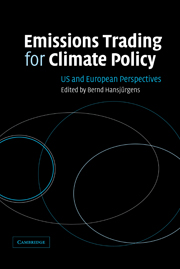Book contents
- Frontmatter
- Contents
- List of figures
- List of tables
- List of contributors
- Preface
- List of abbreviations
- 1 Introduction
- Part 1 Regulatory instruments for climate policy: theoretical aspects
- Part 2 The US approach to pollution control: lessons for climate policy
- 5 Implications of the US experience with market-based environment strategies for future climate policy
- 6 US experience with emissions trading: lessons for CO2 emissions trading
- 7 Climate change policy viewed from the USA and the role of intensity targets
- 8 Design issues of a domestic carbon emissions trading system in the USA
- Part 3 European policies to control greenhouse gases: the EU directive on emissions trading
- 14 Concluding observations
- Index
- References
8 - Design issues of a domestic carbon emissions trading system in the USA
Published online by Cambridge University Press: 22 September 2009
- Frontmatter
- Contents
- List of figures
- List of tables
- List of contributors
- Preface
- List of abbreviations
- 1 Introduction
- Part 1 Regulatory instruments for climate policy: theoretical aspects
- Part 2 The US approach to pollution control: lessons for climate policy
- 5 Implications of the US experience with market-based environment strategies for future climate policy
- 6 US experience with emissions trading: lessons for CO2 emissions trading
- 7 Climate change policy viewed from the USA and the role of intensity targets
- 8 Design issues of a domestic carbon emissions trading system in the USA
- Part 3 European policies to control greenhouse gases: the EU directive on emissions trading
- 14 Concluding observations
- Index
- References
Summary
Introduction
As every student of diplomacy knows, broad international agreements are far easier to craft than specific ones, especially when compliance involves potentially costly domestic actions. While committing the United States and more than 150 other nations to the goal of stabilizing atmospheric greenhouse gas (GHG) concentrations at a level that would “prevent dangerous anthropogenic interference with the climate system,” the UN Framework Convention on Climate Change (FCCC) was mostly silent on implementation. The Kyoto Protocol is an attempt to move beyond the convention's general obligations and establish specific reduction targets for industrial nations for an initial accounting period, 2008–12.
Scholars will no doubt continue to debate whether an alternative protocol design, perhaps one starting with more modest emission reductions among a broader group of nations, might ultimately have yielded stronger results. However, neither the limitations of the protocol's architecture, nor even the gaping hole in coverage among industrial nations caused by the withdrawal of the United States from the agreement alters the fact that, once ratified, the Kyoto Protocol is likely to endure for many years as the only functioning international mechanism for achieving near-term emissions reductions.
A glance into the crystal ball suggests we are entering a period of relative quiescence in the international climate policy process. During this period, the focus of attention will likely shift to the domestic actions undertaken in industrial nations.
- Type
- Chapter
- Information
- Emissions Trading for Climate PolicyUS and European Perspectives, pp. 114 - 132Publisher: Cambridge University PressPrint publication year: 2005
References
- 1
- Cited by

